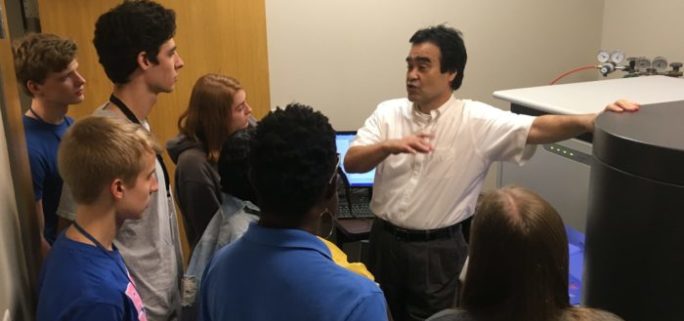Our aim is to foster interest in nanotechnology & give students a head-start in nano industries.
The Mission
Seeing Nano Arkansas seeks to introduce Arkansas’s K-12-grade students to the world of nanoscience by providing, free of charge, the nanoscale imaging capabilities of CINS. Though the future of science, engineering, and biomedical technology—and, as a result, the STEM job field—will be strongly influenced by nanotechnology, the ordinary optical microscopes available at most K-12 schools in Arkansas cannot see objects smaller than 100 nanometers. This means that most students do not have opportunities to actually see or study nanomaterials. As one of the few institutions in the state with instruments capable of imaging nanomaterials, CINS is seeking to address this statewide education gap by providing nanoscale imaging opportunities to Arkansas students. Our aim is to foster strong interest in nanotechnology and give these young scholars a head-start in nanotechnology-based industries.
The Program
- Right now, participation is limited to high schools and junior high schools (7-12th grade).
- The main instruments involved in the project will be 1) JEOL JEM 2100F transmission electron microscope (TEM), 2) JEOL JSM 7000F scanning electron microscope (SEM), and 3) Bruker Icon atomic force microscope (AFM). These 3 microscopes may be supplemented by other analytical instruments at CINS (the complete lists of CINS instruments can be viewed online).
- Every participating school will receive a document and a video “crash course” in nanomaterials and the instrument(s) they will be studying. These videos will feature CINS’s PhD-level researchers and graduate students.
- We will provide interested students/teachers with descriptions of our instruments and guidelines for preparing their own nanoscale samples.
- Participants will send their samples to CINS, and we will image and analyze them then send the results back to the schools. Eventually, we hope to introduce web-based remote viewing of nanomaterials to the classes.
- We will offer CINS tours to the participating students and teachers, allowing them to observe the imaging, analysis, and processing of the specimens they have provided. In some cases, we may also provide on-campus guidance on how to prepare nanomaterials, such as simple chemical synthesis of nanoparticles.
- We will host workshops to introduce the STEM teachers who are interested in participating in our program. In addition, we will hold meeting with teachers individually upon request. These events will introduce our program gather feedback from teachers on the program. Any input from the teachers is appreciated.
This program is led by Dr. Fumiya Watanabe, Director of Instrumentation at CINS, and supported by all CINS staff and graduate students. Dr. Alex Biris, Director of CINS, will oversee the program and advise Dr. Watanabe. The STEM Education office (headed by Mr. Keith Harris) is an important partner in our program. Their expertise and existing connection with the STEM education network in Arkansas are great assets to the program.
How do I get involved?
Educators who want to participate in this program should contact Dr. Watanabe (email: fxwatanabe@ualr.edu, phone: 501-916-6506) or Ms. Annmarie Dill (email: aldill@ualr.edu, phone: 501-916-3456) for participation requirements and more information.
